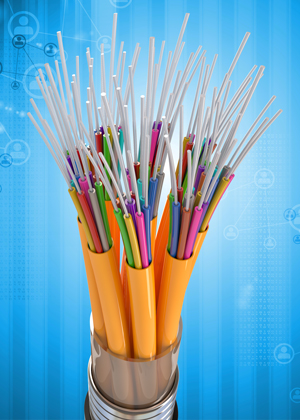Chances are that connectivity is not just another expense item in your business. It is critical to your being in business and for your employee productivity. What you need is solid, reliable, fast, low latency and uncongested network connections to the Internet, cloud services, and your other business locations. This is the time to ensure you have it now and in the future.
 What You Are Looking For Is Fiber
What You Are Looking For Is FiberTelecommunications, the genesis of computer to computer connections, was historically built on twisted pair copper wiring. That era is essentially over. The remaining T1 lines and DS3 coax are relics of an earlier day and will soon be moved to the recycling bin. Not only have they been eclipsed in bandwidth, but the infrastructure buildouts now are based on multi-strand fiber optic cables.
Fiber historically has been expensive and rare. That changed with the introduction of Ethernet over Fiber or EOF services directly compatible with today’s most popular computer networks. Fiber optic Ethernet has the widest availability of bandwidths and the lowest cost per Mbps or Gbps. In many areas, fiber is available to just about every business location and in others it soon will be. As you drive down the road you can see crews installing underground fiber conduits in both business and residential areas.
Where Do You Want to Connect?
The most popular connections are to the public Internet. This is a must if you are going to communicate with customers and suppliers. You can also use the Internet to connect to cloud services and link multiple business locations. The beauty of the Internet is that it is already built-out to connect just about everyone, everywhere. This makes worldwide connections fast and inexpensive.
While the Internet itself is a shared network that doesn’t favor one user over another, you can improve your company’s connection by using dedicated instead of shared access. A DIA or Dedicated Internet Access line is a private connection between your business and your Internet Service Provider. It lets you avoid the congestion that can occur when you are sharing access locally with many other business and consumer users.
Dedicated Cloud On-Ramps
Productivity is key to any business. If a key element to your productivity is provided by cloud services, you may be plagued with varying slowdowns and even dropouts caused by a congested Internet not able to keep up with the massive flow of data between you and your cloud provider. The solution is a direct line between your network and your cloud service provider. This is called a cloud connection or cloud on-ramp. It shields you from competition for bandwidth from other users. Such a dedicated leased line can make the cloud server perform like it is right down the hall.
Multiple Locations on the Same Network
Within your building, you have complete control of your LAN that connects terminals, PCs, printers, storage and so on. With multiple locations, you need some way to connect their networks, since they can’t all be on the same LAN… or can they? Dedicated fiber optic bandwidth can go a long way to creating the perception that all of your users, and perhaps some customers and suppliers, are on the same network with the same performance. This is usually done with a central hub and separate links to each location. For vastly separated locations, you can also achieve similar performance with a dedicated link to a MPLS or Multi-Protocol Label Switching network that provides regional, national or international coverage.
How Fast is Fast?
While single Megabits per second was once considered speedy, It doesn’t cut it for most uses today. Even consumers are demanding 300 Mbps, 600 Mbps or even 1 Gbps or more for their Web access and video streaming. Businesses, especially those with cloud services, must have at least this much. Entry level connections of 1 Gbps are now common. As demands increase or business size expands, 10 Gbps is a readily available and affordable service level. Once core network speeds of 100 Gbps are now being offered to businesses in metro areas and will soon be universally available.
How is this possible? Fiber optic strands have nearly unlimited bandwidth capacity. The limitation is often defined by the equipment powering, switching and terminating the strands. Wavelength division multiplexing divides one strand into a dozen or a hundred separate high bandwidth connections. Each cable may have a dozen to a hundred separate fiber strands.
How much low latency high performance bandwidth do you need? You may be surprised to find how much costs have come down the last few years. See now the availability and pricing for fiber optic connections that can grow with your business.

